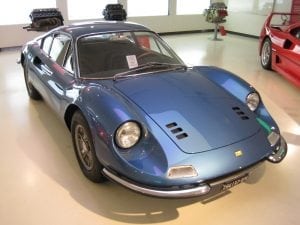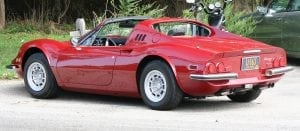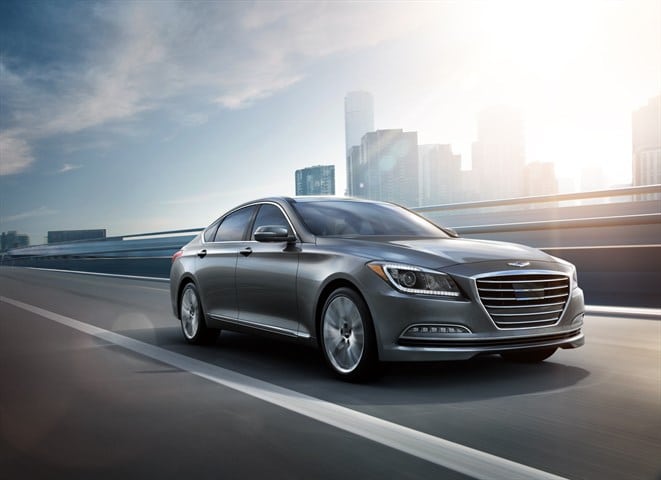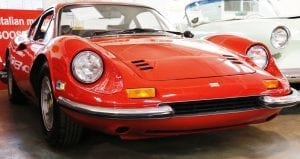 It’s funny to think the first time I saw a Ferrari Dino 246 GT was back in the 1970s on the TV series The Persuaders. Filmed throughout the sunny south of France, Italy and England, cool and suave Roger Moore was driving a stunning yellow Aston Martin DBS, but my eyes were riveted on the passion evoking Ferrari Dino 246GT, driven by the insatiable Tony Curtis. The Ferrari Dino 246GT epitomized my ideal car, with race curves meant to slice the air in effortless speed and looking very fast at a standstill.
It’s funny to think the first time I saw a Ferrari Dino 246 GT was back in the 1970s on the TV series The Persuaders. Filmed throughout the sunny south of France, Italy and England, cool and suave Roger Moore was driving a stunning yellow Aston Martin DBS, but my eyes were riveted on the passion evoking Ferrari Dino 246GT, driven by the insatiable Tony Curtis. The Ferrari Dino 246GT epitomized my ideal car, with race curves meant to slice the air in effortless speed and looking very fast at a standstill.
When Ferrari Dino 246GT Wasn’t On The Collector’s Radar
We probably should make the obvious distinction between a Ferrari and the Dino 246GT. Much confusion stemmed when the Ferrari introduced the Dino brand meant to differentiate the company’s mid-engine, rear-drive sports cars produced between 1968 to 1976 with a smaller V6 or V8 displacement from the V12 cars. Was it a Ferrari? At the time the purist gave it a resounding no. It was missing the crucial V12.
Named in honor of Enzo Ferrari’s son, Dino Ferrari who lost his life in a tragic accident, the Dinos used Ferrari racing naming convention, displacement, cylinder, and a two digit representation of the deciliters engine. The third set of digits represent the number of cylinders. Thus the 246 GT is a two-liter V6. Much like Porsche’s 912, the Dino’s were the affordable sports car from Ferrari. The Dino’s sported Dino’s original V6 design, with the help of Alfa Romeo famed Vittorio Jano, which was used on its smaller displacement 1950s race cars.
The Dino 246GT Mid-Engine Convinced Enzo Ferrari
It took years for Ferrari to adopt independent suspension front wheels. The same can be said about a mid-engine layout for its road cars. However, Colin Chapman had been successfully racing his mid-engine race cars and local competitor wanna-be Ferruccio Lamborghini had already created his exuberant 1966 mid-engined Miura, much to the public’s greatest surprise. Scaglietti was given the go ahead to build a mid-engined concept for the 1965 Paris Motor Show for the 206 GT with a Dino badge. This gave birth the following year to the Dino 206S. The public enthusiasm eventually forced Enzo to acknowledge that a V6 and V8 mid-engine design made commercial sense.
Thus, the 1968 Dino 206 GT was born and would soon herald the Dino 246GT!
Technically Speaking, The Dino 206 GT
The 1969 206 GT was replaced by a more powerful Dino 246 GT sporting a 2418 cc 65-degree, dual-overhead-camshaft, 9.0:1 compression ratio, iron block with alloy heads V6. It put out an honorable 195 HP at 7,600 RPM for its time. The US got a modified version with an exhaust air-pump and timing changes, which reduced the power to 175 HP. The Dino 246GT was offered as a fixed-top GT coup first and a targa GTS later in 1971. Contrary to the 206, the body was now made of steel and rested on a longer wheelbase. The Dino 246GT also did away with the 206 GT’s 3 Weber 40 DCNF/6 or 40 DCNF/7 carburetors configuration and adopted a Magneti Marelli Dinoplex ignition system. This made for a top speed of 146 mph, although Britain’s Motor magazine reported 148 mph. It weighed 2,380 lb and the GTS, 2,426 lb.
There were a few subtle differences between the three series of Dino 246 GTs. Those differences were the wheels of the first series had a with a central knock off, different windshield wiper covers, and most importantly, engine vents changed. All in all, the Dino 246 GT was produced to the tune of 2,295 GTs and 1,274 GTSs for a total production of 3,569 units.
The Ferrari Dino 246 GT Broke Grounds
Although many consider the Ferrari 308 GT4 as the initial departure from the company’s few hand-built early road cars, the honor goes to the Dino 206 and 246 as being truly the first high number production road cars for Ferrari. They subsequently gave birth to the 308 series. At the time, although the Dino 246 GT was lauded for its great driving dynamics, its groundbreaking design is what caught the attention of most. It became a modern and new mythical 1960s Ferrari.
I have loved Sports Prototype since the sixties. Those long, aerodynamic swoops, elegant air flow robes on those 1960s and 1970s long distance runners have always fascinated me. What is there not to love about an Alfa Romeo 33 Stradale, a Ferrari 330 P4 or a Lola T70 MKIII? The Dino 246 GT broke the design ground. Only an Italian company could offer a stunning looking car that looked ready to leap the 24 Heure du Mans, as a regular day in, day out road car. It was the affordable way to own a performance car that looked as if it could race in a world endurance series.

Beverly Hills Car Club Offering a Dino 246 GT!
It stopped me in tracks again, some 45 years later. It is still a great looking car. It still conjures memories of Tony Curtis hurdling his Dino 246 GT through the windy streets of southern France. When I walked into the Beverly Hills Car Club showcase, I stopped and rekindled with this old love of mine. A Dino 246 GT has always been and will always be a looker that heralded a historical transition for Ferrari, without losing any of its DNA.
Today, the Beverly Hills Car Club is happy to announce that it is offering a 1972 Ferrari Dino 246 GT, lot # 06918 in a must have rossa corsa with a black interior. The timeless color combination suits the Dino 246 GT to perfection. It is mechanically sound and priced very aggressively at $287,500.
As for me, the first thing I did when I got back home after an ample photo shoot and a myriad of video clips of the car, was to find The Persuaders series online. I immerse myself in this nostalgic era when the Dino 246 GT was associated with a stylish French Riviera scenery and a certain je ne sais quoi Dolce Vita. It can now be yours.
Appeared originally on the Beverly Hills Car Club site.








